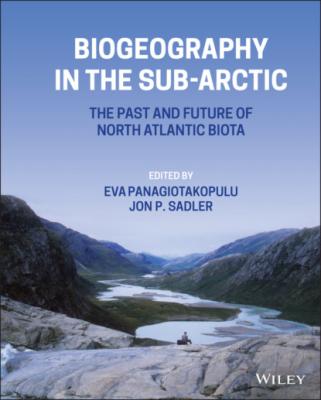Biogeography in the Sub-Arctic. Группа авторов
Читать онлайн.| Название | Biogeography in the Sub-Arctic |
|---|---|
| Автор произведения | Группа авторов |
| Жанр | География |
| Серия | |
| Издательство | География |
| Год выпуска | 0 |
| isbn | 9781118561355 |
Limit of Liability/Disclaimer of Warranty While the publisher and authors have used their best efforts in preparing this work, they make no representations or warranties with respect to the accuracy or completeness of the contents of this work and specifically disclaim all warranties, including without limitation any implied warranties of merchantability or fitness for a particular purpose. No warranty may be created or extended by sales representatives, written sales materials or promotional statements for this work. The fact that an organization, website, or product is referred to in this work as a citation and/or potential source of further information does not mean that the publisher and authors endorse the information or services the organization, website, or product may provide or recommendations it may make. This work is sold with the understanding that the publisher is not engaged in rendering professional services. The advice and strategies contained herein may not be suitable for your situation. You should consult with a specialist where appropriate. Further, readers should be aware that websites listed in this work may have changed or disappeared between when this work was written and when it is read. Neither the publisher nor authors shall be liable for any loss of profit or any other commercial damages, including but not limited to special, incidental, consequential, or other damages.
Library of Congress Cataloging-in-Publication Data is applied for
ISBN 9781118561478
Cover Design: Wiley
Cover Image: © Eva Panagiotakopulu
List of Contributors
Inger G. Alsos The Arctic University Museum of Norway TromsøNorway
Ole Bennike Geological Survey of Denmark and Greenland Copenhagen Denmark
Jens Böcher Zoological Museum Copenhagen Denmark
Christian Brochmann The Natural History Museum University of Oslo Oslo Norway
Thomas Denk Department of Palaeobiology Swedish Museum of Natural History Stockholm Sweden
Gaston R. Demarée Royal Meteorological Institute of Belgium Brussels Belgium
Kevin J. Edwards Department of Geography and Environment and Department of Archaeology School of Geosciences, University of Aberdeen Aberdeen UK Scott Polar Research Institute and McDonald Institute for Archaeological Research University of Cambridge Cambridge UK
Egill Erlendsson Department of Geography and Tourism Faculty of Life and Environmental Sciences University of Iceland Reykjavík Iceland
Anna Maria Fosaa Faroese Museum of Natural History Tórshavn Faroe Islands
Gísli Már Gíslason Institute of Life and Environmental Sciences University of Iceland Reykjavík Iceland
Friðgeir Grímsson Department of Botany and Biodiversity Research University of Vienna Vienna Austria
Jennifer Harland Archaeology Institute University of the Highlands and Islands Orkney College Kirkwall UK
Erlingur Hauksson Fornistekkur 14 Reykjavík Iceland
Henning Heide‐Jørgensen Department of Biology University of Copenhagen Copenhagen Denmark
Brian T. Hill Institute for Ocean Technology National Research Council Canada
Ib Johnsen Department of Biology University of Copenhagen Copenhagen Denmark
Ingrid Mainland Archaeology Institute University of the Highlands and Islands Orkney College Kirkwall UK
Astrid E. J. Ogilvie Stefansson Arctic Institute Akureyri Iceland Institute of Arctic and Alpine Research(INSTAAR)University of Colorado Boulder CO USA
Bergur Olsen Faroe Marine Research Institutre Faroe Islands
Eva Panagiotakopulu School of Geo Sciences University of Edinburgh Edinburgh UK
Aevar Petersen Brautarland 2 Reykjavík Iceland
Jon P. Sadler School of Geography Earth and Environmental Sciences The University of Birmingham Birmingham UK
J. Edward Schofield Department of Geography and Environment School of Geosciences University of Aberdeen Aberdeen UK
Thóra Ellen Thórhallsdóttir Institute of Life and Environmental Sciences University of Iceland Reykjavík Iceland
Brian G. J. Upton School of Geo Sciences University of Edinburgh Edinburgh UK
Bernd Wagner Institute of Geology and Mineralogy University of Cologne Cologne Germany
Reinhard Zetter Department of Palaeontology University of Vienna Vienna Austria
Introduction
Jon P. Sadler1 and Eva Panagiotakopulu2
1 School of Geography, Earth and Environmental Sciences, The University of Birmingham, Birmingham, UK
2 School of GeoSciences, University of Edinburgh, Edinburgh, UK
There is no escaping the fact that the island biogeography of the North Atlantic Region is singularly peculiar. While it has aspects of the characteristics of many island groups in terms of disharmonic and impoverished species pools (Coope 1986), it lacks true endemics (Buckland 1988; Downes 1988, but cf. Böcher 1988), although it is home to a wide number of putative subspecies and races (e.g. Lindroth 1968; Löve and Löve 1963). Sitting in the north of the Atlantic Ocean these islands have been subjected to large‐scale shifts in climate over the last few million years, unlike the other island groups further south which were likely buffered from the vicissitudes of Quaternary climate changes (Sadler 2001). Unlike island groups elsewhere, there is only one documented extinction on these island groups (the Great Auk) and those in the insects are local events relating to species that are distributed throughout the Palaearctic region. Over half the insect species in Iceland and Greenland are non‐indigenous and many of these were first introduced to the islands by the Norse colonists (Buckland 1988; Panagiotakopulu 2014; Sadler 1990). The faunas, excluding Greenland (Böcher 1988, are predominantly Palaearctic (Buckland 1988; Downes 1988; Lindroth 1931), and have close affinities with the faunas of the British Isles and Scandinavia. These unique physical and biological characteristics have interested biologists and biogeographers for centuries (Hooker 1862).
In their seminal book North Atlantic Biota and Their History, Löve and Löve (1963) concluded that plants survived the heavily glaciated Atlantic areas, in ‘glacial refuges’ or ‘nunataks’, dismissing the earlier ‘now merely historical’ tabula rasa idea – the hypothesis that the current Atlantic floras were established following postglacial immigration from source areas situated outside the ice sheets. The virtually complete consensus among plant biogeographers (with notable exceptions among some palaeoecologists) at that time was based on two main arguments, the occurrence of (a) disjunct and (b) endemic taxa in the North Atlantic region. Firstly, the presence of disjuncts was believed to necessitate in situ glacial survival because long‐distance
